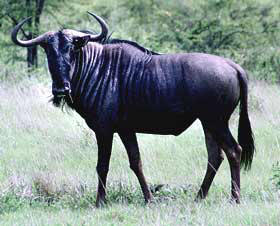The
country of South Africa lies at the very southern tip of the African
continent. It is bordered by two of the worlds oceans, the Atlantic
Ocean on the west, and the Indian Ocean on the east. South Africa shares
its land borders with more countries than any other in Africa. It has
six different countries as neighbours. These countries are Botswana,
Namibia, Mozambique, Zimbabwe, Swaziland and Lesotho. The country of
Lesotho is a landlocked country completely surrounded by South Africa.
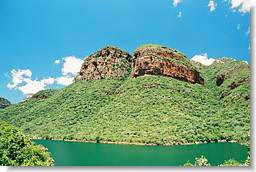 The
total area the country covers is 1,219,912 sq. km with a coastline 2,798
km long. In comparison, the country is slightly less than twice the size
of the U.S. state of Texas.
The
total area the country covers is 1,219,912 sq. km with a coastline 2,798
km long. In comparison, the country is slightly less than twice the size
of the U.S. state of Texas.
The
country can be divided into three geographical areas. The
central plateau called The Highveld, the narrow coastal
plains called The Lowveld,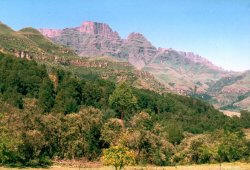 and the desert area of the Kalahari Basin. Although the country
has several rivers, its lack of big arterial rivers and lakes
has resulted in water shortages as the growth in water usage
threatens to outpace the actual supply of water.
and the desert area of the Kalahari Basin. Although the country
has several rivers, its lack of big arterial rivers and lakes
has resulted in water shortages as the growth in water usage
threatens to outpace the actual supply of water.
The
interior of South Africa is a giant, rather flat, and sparsely
populated scrubland Karoo, which is drier towards the northwest
along the Namib desert. In contrast, the eastern coastline is
lush and well-watered, which produces a climate similar to the
tropics.
The extreme
southwest has a climate remarkably similar to that of the
Mediterranean with wet winters and hot, dry summers, hosting the
famous Fynbos Biome. This area also produces much of South
Africa's wine. This region is also particularly known for its
wind, which blows intermittently almost all year. The severity
of this wind made passing around the Cape of Good Hope
particularly treacherous for sailors, causing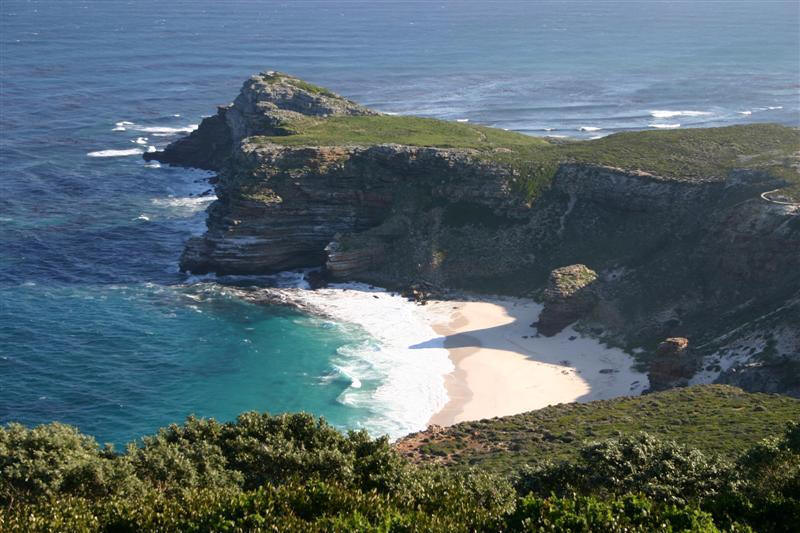 many shipwrecks.
many shipwrecks.
Environmental
issues that exist include pollution of rivers from agricultural runoff
and industrial uses, acid rain in areas where coal is used as a source
of energy, soil erosion in overpopulated areas and desertification in
areas where grasslands are being lost due to over-grazing of livestock.
The two
major ocean currents found offshore affect the temperature of the
seasons. The cold Benguela current causes moderate temperatures on the
West Coast, and on the central plateau the altitude tends to keep the
average temperatures below 30° C. In winter, also due to altitude,
temperatures can drop to the freezing point. The warm Aqulhas current
flows along the eastern coast causing higher temperatures and increased
rainfall.
In
general, the dry season runs from June through August although along the
southern cape region, including Cape Town, temperatures are the opposite
of the rest of the country.
Savanna
A savanna or savannah is
grassland with widely spaced trees, and occurs in several types of
biomes. In savannas, grasses and trees are co-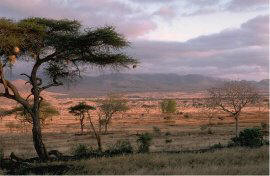 dominant
vegetation types, with trees and grasses often alternating in
dominance over time. The herbaceous layer is usually a mixture of
grasses and herbs with trees and shrubs scattered individually or in
small clumps. Savannas are frequently seen as a transitional zone,
occurring between forest or woodland regions and grassland or desert
regions.
dominant
vegetation types, with trees and grasses often alternating in
dominance over time. The herbaceous layer is usually a mixture of
grasses and herbs with trees and shrubs scattered individually or in
small clumps. Savannas are frequently seen as a transitional zone,
occurring between forest or woodland regions and grassland or desert
regions.
Although
the term savanna is believed to have originally come from an
Amerindian word describing "land which is without trees but with
much grass either tall or
short, by the late 1800s it was used to mean "land
with both grass and trees". It now refers to land with grass and
either scattered trees, or an open canopy of trees. Savanna
are of several different types but the savannas of Africa,
including the Serengeti, famous for its wildlife, are typical of
this type.
South
Africa has more than 20,000 different plants, or about 10% of all the
known species of plants on Earth, making it particularly rich in plant
biodiversity.
South Africa's most
prevalent biome is grassland, particularly on the Highveld, where
the plant cover is dominated by different grasses, low shrubs, and
acacia trees, mainly camel-thorn and whitethorn. Vegetation
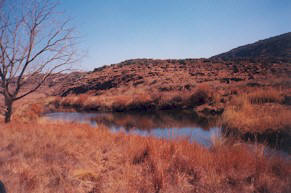 becomes
even more sparse towards the northwest due to low rainfall. There are
several species of water-storing succulents like aloes and euphorbias in
the very hot and dry Namaqualand area. There are significant numbers of
baobab trees in this area, near the northern end of Kruger National
Park.
becomes
even more sparse towards the northwest due to low rainfall. There are
several species of water-storing succulents like aloes and euphorbias in
the very hot and dry Namaqualand area. There are significant numbers of
baobab trees in this area, near the northern end of Kruger National
Park.
 The
total area the country covers is 1,219,912 sq. km with a coastline 2,798
km long. In comparison, the country is slightly less than twice the size
of the U.S. state of Texas.
The
total area the country covers is 1,219,912 sq. km with a coastline 2,798
km long. In comparison, the country is slightly less than twice the size
of the U.S. state of Texas.
 and the desert area of the Kalahari Basin. Although the country
has several rivers, its lack of big arterial rivers and lakes
has resulted in water shortages as the growth in water usage
threatens to outpace the actual supply of water.
and the desert area of the Kalahari Basin. Although the country
has several rivers, its lack of big arterial rivers and lakes
has resulted in water shortages as the growth in water usage
threatens to outpace the actual supply of water.
 many shipwrecks.
many shipwrecks.
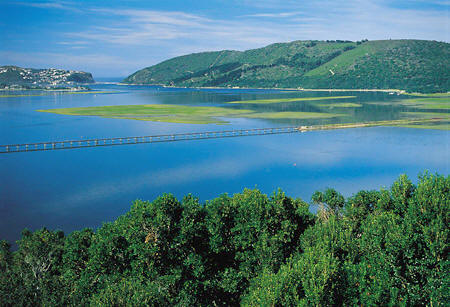
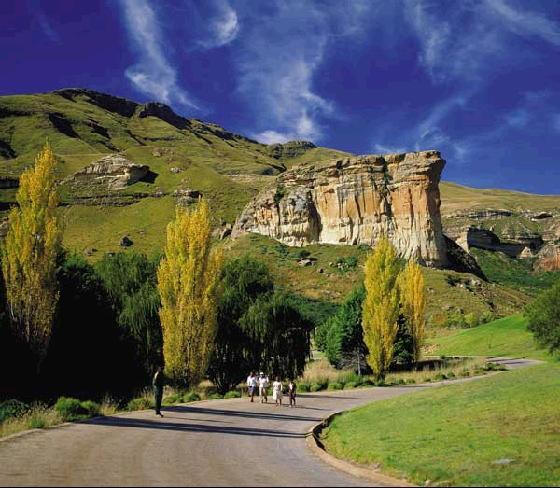
 dominant
vegetation types, with trees and grasses often alternating in
dominance over time. The herbaceous layer is usually a mixture of
grasses and herbs with trees and shrubs scattered individually or in
small clumps. Savannas are frequently seen as a transitional zone,
occurring between forest or woodland regions and grassland or desert
regions.
dominant
vegetation types, with trees and grasses often alternating in
dominance over time. The herbaceous layer is usually a mixture of
grasses and herbs with trees and shrubs scattered individually or in
small clumps. Savannas are frequently seen as a transitional zone,
occurring between forest or woodland regions and grassland or desert
regions.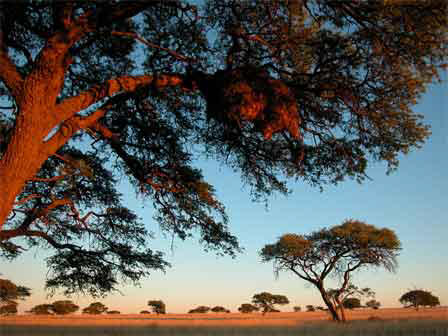
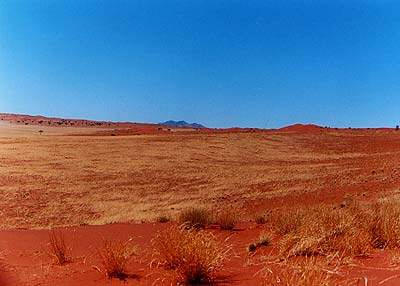

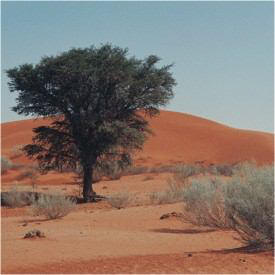 mm
of rain annually) making the Kalahari a fossil desert. Summer
temperatures in the Kalahari range from 20 to 40 °C. In winter, the
Kalahari has a dry, cold climate with frosts at night. The low winter
temperature can average below 0 °C.
mm
of rain annually) making the Kalahari a fossil desert. Summer
temperatures in the Kalahari range from 20 to 40 °C. In winter, the
Kalahari has a dry, cold climate with frosts at night. The low winter
temperature can average below 0 °C.  becomes
even more sparse towards the northwest due to low rainfall. There are
several species of water-storing succulents like aloes and euphorbias in
the very hot and dry Namaqualand area. There are significant numbers of
baobab trees in this area, near the northern end of Kruger National
Park.
becomes
even more sparse towards the northwest due to low rainfall. There are
several species of water-storing succulents like aloes and euphorbias in
the very hot and dry Namaqualand area. There are significant numbers of
baobab trees in this area, near the northern end of Kruger National
Park. 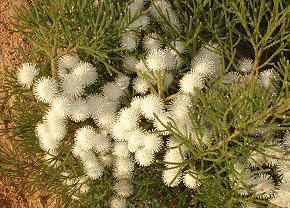
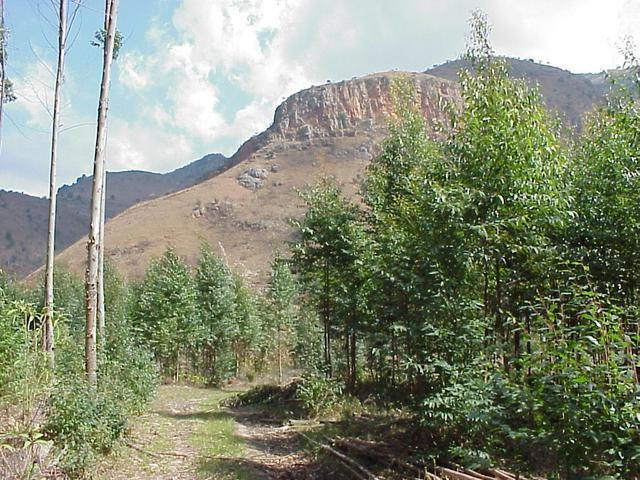
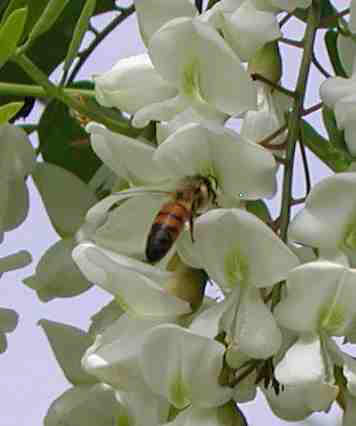 South
Africa has lost extensive acreage of natural habitat in the last four
decades, primarily due to overpopulation, sprawling development patterns
and deforestation during the nineteenth century.
South
Africa has lost extensive acreage of natural habitat in the last four
decades, primarily due to overpopulation, sprawling development patterns
and deforestation during the nineteenth century. 
